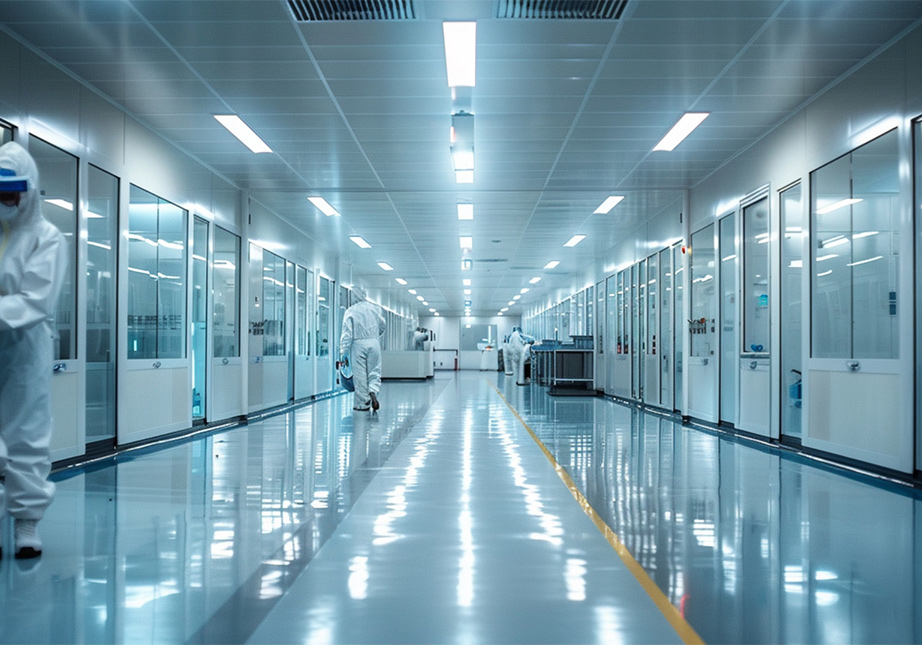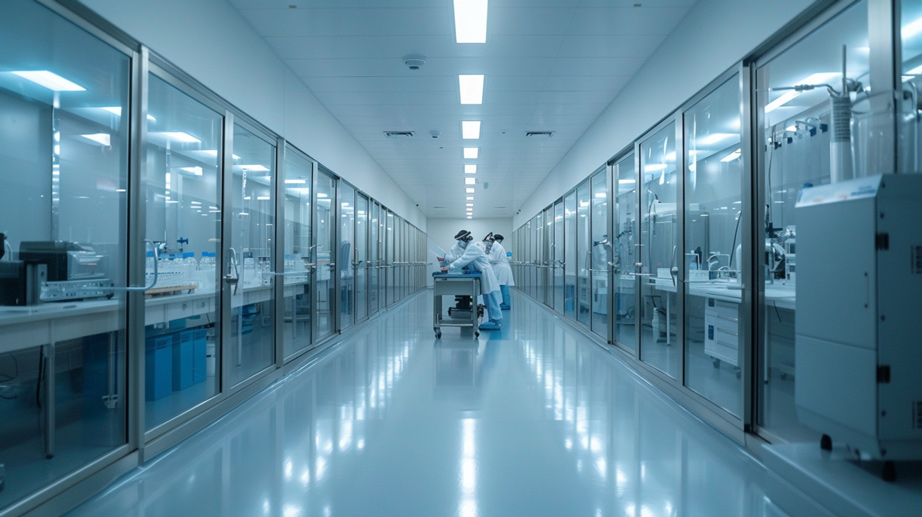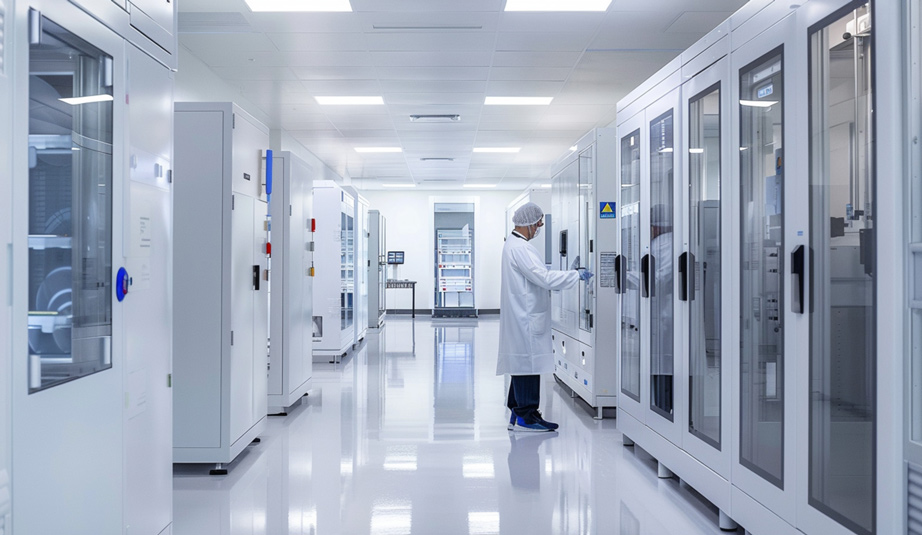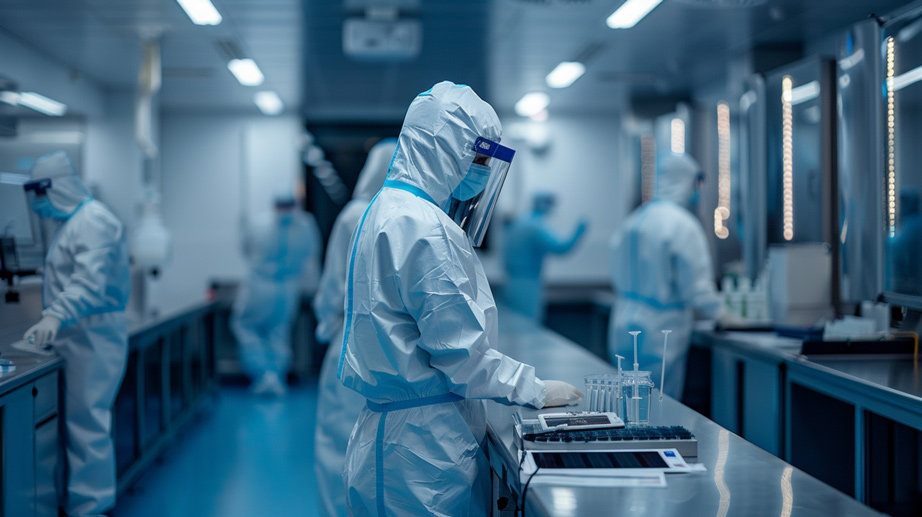
Jun 06, 2024
Medical Cleanrooms
Introduction to Medical Cleanrooms
Medical cleanrooms are specialized environments designed to maintain extremely low levels of particulates, such as dust, airborne microbes, and aerosol particles. Their primary purpose is to create a contamination-controlled area where sensitive activities related to healthcare, pharmaceutical manufacturing, and scientific research can be conducted.
Distinctive Features of Medical Cleanrooms
Unlike standard industrial or research cleanrooms, medical cleanrooms are tailored to meet stringent regulatory requirements. They are essential for the production of sterile medical devices, the preparation of injectable medications, and the development of vaccines, where even the smallest contamination can have significant consequences.
Core Components of Medical Cleanrooms
Key components of a medical cleanroom include High-Efficiency Particulate Air (HEPA) filtration systems, controlled airflow, temperature, and humidity, as well as materials and surfaces that resist contamination. Our modular cleanroom solutions at G-CON are designed with these critical components in mind, ensuring compliance with the highest industry standards.
The Critical Role in Healthcare and Pharmaceuticals
Medical cleanrooms play a pivotal role in ensuring the safety and efficacy of medical products. By providing a controlled environment, they prevent the introduction, generation, and retention of contaminants during the manufacturing process. This is crucial in healthcare and pharmaceutical industries where product purity directly impacts patient health and safety.
Understanding ISO Classifications for Medical Cleanrooms
When you’re delving into the specifics of medical cleanrooms, ISO classifications are a cornerstone. These classifications are pivotal in determining the level of cleanliness and the types of activities that can be safely conducted within these controlled environments.
ISO Classifications Explained
The International Standards Organization (ISO) has established a series of classifications for cleanrooms, denoted as ISO 1 through ISO 9. The classification number corresponds to the maximum allowable particles, measuring 0.1 micrometers or larger, per cubic meter of air. For instance, an ISO 1 cleanroom permits no more than 10 particles per cubic meter, making it the most stringent classification.
Impact on Design and Operation
ISO classifications directly influence the design and operation of medical cleanrooms. The more stringent the classification, the more robust the air filtration and environmental control systems need to be. This includes the use of High-Efficiency Particulate Air (HEPA) or Ultra Low Particulate Air (ULPA) filters, as well as precise control over temperature, humidity, and pressure.
Criteria for Classification
The appropriate ISO classification for a medical cleanroom is determined by the level of cleanliness required for the processes taking place within it. Factors such as the type of product being manufactured, the risk of microbial contamination, and regulatory requirements all play a role in this decision.
Alignment with G-Con’s Modular Solutions
Our modular cleanroom solutions at G-Con are designed to meet various ISO classifications. From standardPOD to megaPOD, we ensure that our prefabricated units comply with the necessary standards, providing you with a controlled environment tailored to your specific medical or pharmaceutical needs.
Design Principles for Medical Cleanrooms
Designing a medical cleanroom requires meticulous planning to ensure a sterile environment that meets regulatory standards. At G-Con, we prioritize these design principles to deliver optimal cleanroom solutions.
Airflow, Pressure, and Filtration
Airflow patterns are engineered to facilitate unidirectional or laminar flow, reducing the risk of cross-contamination. Pressure differentials are maintained to create a cascade effect, ensuring that cleaner air always flows into less clean areas. Our cleanrooms incorporate HEPA or ULPA filters to remove particulate matter effectively, essential for maintaining the ISO-classified environment you require.
Material Selection
The materials used in constructing medical cleanrooms are selected for their durability and non-particulate shedding properties. Surfaces are smooth and impervious, minimizing the accumulation of contaminants and facilitating easy cleaning. We understand that the integrity of your cleanroom is paramount, which is why we use materials that support sterile conditions.
Modular Cleanroom Advantages
Our modular cleanroom solutions, including standardPOD, mobilisPOD, and megaPOD, offer significant advantages. They are prefabricated, which allows for rapid deployment and scalability. Customization is another benefit, ensuring that your cleanroom meets the specific needs of your medical or pharmaceutical operations. With advanced automation and control systems, our modular cleanrooms provide the flexibility and reliability essential for today’s dynamic industry demands.
Air Filtration and Environmental Control in Medical Cleanrooms
Essential Filtration Systems
Medical cleanrooms utilize advanced air filtration systems to maintain the required ISO cleanliness levels. High-Efficiency Particulate Air (HEPA) filters are the standard in these environments, capturing particles as small as 0.3 micrometers with 99.97% efficiency. For even more stringent requirements, Ultra Low Particulate Air (ULPA) filters are employed, which can remove particles as small as 0.12 micrometers with a higher efficiency rate.
Managing the Cleanroom Climate
Environmental control systems are integral to medical cleanroom operations. They meticulously regulate temperature, humidity, and pressure to create a stable environment that minimizes the risk of contamination. By maintaining specific conditions, these systems ensure that sensitive medical manufacturing processes are protected from environmental variables.
The Role of HEPA Filtration
HEPA filtration is critical for sustaining air purity within medical cleanrooms. These filters are a primary defense against particulate contamination, ensuring that the air meets the stringent standards necessary for medical device manufacturing and pharmaceutical processes.
Maintenance and Inspection Protocols
To guarantee ongoing compliance with ISO standards, air filtration and environmental control systems must be regularly inspected and maintained. Our team at G-Con recommends a comprehensive evaluation of these systems at least biannually, with more frequent checks for cleanrooms with higher ISO classifications or those in constant use. This ensures that your cleanroom’s integrity is never compromised, and operational excellence is maintained.
Protocols for Cleaning and Disinfection
Maintaining the sterility of medical cleanrooms is paramount for ensuring the safety and efficacy of medical devices and pharmaceuticals. At G-Con, we adhere to stringent cleaning and disinfection protocols that align with ISO classifications and regulatory guidelines.
Standard Cleaning Procedures
Our standard protocols for cleaning and disinfection are designed to meet the specific requirements of each ISO class cleanroom. This includes the use of approved disinfectants and cleaning agents that are effective against a broad spectrum of microorganisms and are compatible with the cleanroom surfaces.
Variations Across ISO Classifications
The frequency and rigor of cleaning procedures escalate with the stringency of the ISO classification. For instance, ISO 5 environments may necessitate daily cleaning, while ISO 8 may require less frequent schedules. We provide clear guidelines on the cleaning regimen appropriate for your cleanroom’s classification.
Recommended Cleaning Agents and Equipment
We recommend using non-particulate shedding mops, wipes, and sponges in conjunction with cleaning agents that have been validated for use in cleanrooms. Our team can assist you in selecting the right products that are both effective and safe for your cleanroom’s specific materials and surfaces.
Modular Cleanroom Cleaning Advantages
Our modular cleanrooms are designed with smooth, non-porous surfaces that are easy to clean and disinfect. The prefabricated nature of our POD® Cleanrooms allows for the integration of features that simplify maintenance, such as coved flooring and wall joints, reducing the accumulation of contaminants and facilitating efficient cleaning processes.
Regulatory Oversight of Medical Cleanrooms
Medical cleanrooms are subject to stringent regulatory oversight to ensure they meet the necessary standards for sterility and contamination control. Understanding these regulations is crucial for maintaining compliance and ensuring the safety of medical products.
Governing Bodies and Standards
The Food and Drug Administration (FDA) and the International Standards Organization (ISO) are primary regulatory bodies that oversee standards and compliance for medical cleanrooms. The FDA provides guidelines for cleanroom operations within the United States, particularly for the pharmaceutical and medical device industries, while ISO standards, such as ISO 14644 and ISO 13485, are internationally recognized for cleanroom classification and quality management systems.
Impact of Regulations on Operations
Compliance with FDA and ISO regulations is integral to medical cleanroom operations. These regulations dictate the design, monitoring, and maintenance of cleanrooms, ensuring that they are capable of producing safe and effective medical products. Adherence to these standards affects every aspect of cleanroom functionality, from air quality to personnel training.
Certification Process
Certification of a medical cleanroom involves a rigorous audit process. This includes design evaluation, installation assessment, operational qualification, and performance qualification. Our team at G-Con guides you through this process, ensuring that your cleanroom meets all necessary criteria for certification.
Design and Maintenance Considerations
Regulatory compliance directly influences cleanroom design and maintenance. Features such as air filtration systems, construction materials, and environmental monitoring devices must all conform to regulatory standards. At G-Con, our modular cleanrooms are designed with these requirements in mind, providing you with a solution that not only meets but exceeds regulatory expectations.
Training and Personnel Protocols in Medical Cleanrooms
Essential Training for Cleanroom Personnel
Personnel working in medical cleanrooms must undergo comprehensive training. This training encompasses the principles of contamination control, proper use of cleanroom technology, and adherence to standard operating procedures (SOPs). At G-Con, we emphasize the importance of this foundational training to ensure that your staff is well-prepared to maintain the integrity of the cleanroom environment.
Gowning Procedures and Contamination Risk Reduction
Gowning procedures are a critical aspect of cleanroom protocols. Proper gowning reduces the risk of contamination by minimizing the introduction of particulates from personnel. We provide detailed instructions on gowning techniques, ensuring that your team is proficient in dressing in a manner that upholds the cleanliness standards of your medical cleanroom.
Ongoing Training and Compliance Monitoring
To maintain compliance with regulatory standards, ongoing training and monitoring are imperative. Our modular cleanroom solutions facilitate this process by incorporating features that support easy observation and supervision of personnel behaviors, allowing for prompt corrective actions when necessary.
Modular Design Benefits for Personnel Flow
Our modular cleanrooms are designed to optimize personnel flow, thereby enhancing compliance. The layout of entry and exit points, gowning areas, and workspaces is strategically planned to prevent cross-contamination and ensure a logical sequence of operations. This design consideration is integral to the effectiveness of your cleanroom’s contamination control strategy.
Innovations in Medical Cleanroom Technology
The landscape of medical cleanroom technology is continually evolving, with recent advancements focusing on enhancing efficiency and compliance. At G-Con, we are at the forefront of integrating these innovations into our modular cleanroom solutions.
Technological Advancements
Recent developments in medical cleanroom technology have centered around automation and advanced monitoring systems. These include:
- Automated Environmental Monitoring: Real-time systems that continuously assess particulate matter, temperature, and humidity levels, ensuring adherence to cleanroom protocols.
- Robotics: Use of robotic systems for repetitive tasks to minimize human intervention and potential contamination.
- Advanced HVAC Systems: Enhanced HVAC systems that regulate air changes per hour (ACH) more efficiently, crucial for meeting ISO standards.
Enhancing Efficiency and Compliance
Automation and monitoring systems play a pivotal role in cleanroom operations by:
- Reducing manual errors and increasing precision in environmental control.
- Providing continuous data for compliance with regulatory standards.
- Allowing for remote monitoring and adjustments, which can lead to quicker responses to environmental changes.
Future Trends
Emerging trends in medical cleanroom technology include:
- Integration of IoT: Connecting cleanroom systems to the Internet of Things (IoT) for smarter data analytics and predictive maintenance.
- Sustainability: Designing cleanrooms with energy-efficient systems and materials to reduce environmental impact.
G-Con’s Role in Innovation
Our commitment to innovation is reflected in our modular cleanroom offerings, which incorporate these technological advancements to provide state-of-the-art, ISO-compliant environments. By embracing these trends, we ensure that our cleanrooms are not only effective today but are also prepared for the future demands of the medical and pharmaceutical industries.
Addressing Challenges in Medical Cleanroom Management
Managing medical cleanrooms involves navigating a complex array of challenges, from maintaining stringent sterility standards to ensuring regulatory compliance. At G-Con, we understand these challenges and offer solutions through our modular cleanroom designs.
Design and Operational Strategies
Our design strategies focus on minimizing contamination risks. This includes the use of non-particulate shedding materials and the integration of advanced air filtration technologies, such as HEPA and ULPA filters, essential for maintaining ISO-classified environments. Operationally, we advocate for rigorous training programs and the implementation of strict standard operating procedures (SOPs) to mitigate human-induced contamination.
Technological Solutions
Technology plays a crucial role in overcoming cleanroom management challenges. Our cleanrooms are equipped with environmental monitoring systems that provide continuous assessment of particulate matter and microbial contamination, ensuring adherence to cleanroom protocols. Additionally, the use of antistatic materials and ESD control is crucial for preventing static damage in sensitive production environments.
Modular Cleanroom Advantages
Modular cleanrooms by G-Con, including our standardPOD, mobilisPOD, and megaPOD, offer customizable, ISO-compliant solutions that address common management challenges. The prefabricated nature of these cleanrooms allows for rapid deployment and scalability, while integrated advanced automation and control systems cater to the specific needs of the pharmaceutical and biopharmaceutical sectors.
Criteria for Equipment and Material Selection in Medical Cleanrooms
Selecting the right equipment and materials for medical cleanrooms is a process guided by stringent criteria to ensure compliance with ISO standards and regulatory requirements.
Material Properties and Cleanroom Functionality
Materials chosen for cleanrooms must have non-shedding properties to minimize particulate contamination. They should also be resistant to the chemicals used for cleaning and disinfection. Durability and ease of cleaning are paramount to maintain the functionality and sterility of the cleanroom.
Equipment Considerations for Cleanroom Operations
Equipment used within medical cleanrooms must support the operational requirements while minimizing the risk of contamination. This includes selecting items with smooth surfaces and minimal crevices where particles could accumulate. Additionally, equipment should be compatible with the cleanroom’s environmental conditions, such as humidity and temperature ranges.
Integration of G-Con’s Modular Solutions
Our modular cleanroom solutions are designed to seamlessly integrate with a wide range of equipment and material specifications. Whether you require standardPOD, mobilisPOD, or megaPOD configurations, we ensure that the design accommodates the necessary equipment while adhering to the relevant ISO classification. Our team works closely with you to understand your specific requirements, ensuring that our cleanroom solutions enhance your operational efficiency and compliance.
Strategies for Optimal Environmental Conditions
Maintaining optimal environmental conditions in medical cleanrooms is critical for ensuring the integrity of the processes and products within. At G-Con, we implement robust strategies to achieve and sustain the required conditions.
Environmental Control through Advanced Monitoring
Our cleanrooms are equipped with state-of-the-art monitoring systems that continuously track and adjust temperature, humidity, and pressure levels. These systems are essential for environmental control, providing real-time data that allows for immediate corrective actions when deviations occur.
Consequences of Environmental Deviations
Failure to maintain prescribed environmental conditions can lead to compromised product quality, increased contamination risk, and non-compliance with regulatory standards. It is imperative that these conditions are closely managed to prevent such outcomes.
Modular Cleanrooms and Environmental Monitoring
The design of our modular cleanrooms facilitates streamlined environmental control and monitoring. With integrated systems that are easily accessible and adjustable, our cleanrooms ensure that maintaining the necessary conditions is both efficient and effective. This design approach supports your commitment to quality and compliance in the highly regulated medical and pharmaceutical industries.
Tailored Modular Cleanroom Solutions by G-Con
At G-Con, we understand that each medical cleanroom project has unique requirements. Our modular cleanroom solutions are designed to be flexible and scalable, ensuring they meet the specific needs of your operations.
Customized Design and Construction Support
Our team provides comprehensive support throughout the design and construction phases. We work closely with you to ensure that every aspect of the cleanroomfrom airflow patterns to material selectionaligns with your process requirements and regulatory obligations.
Starting Your Cleanroom Project
To initiate a consultation for your medical cleanroom project, you can contact us directly. Our experts are ready to discuss your needs, answer any questions, and guide you through the planning and implementation stages.
Why Choose G-Con?
Choosing G-Con for your cleanroom needs means selecting a partner committed to quality, compliance, and innovation. Our prefabricated cleanrooms are not only ISO-compliant but also integrate advanced automation and control systems, making them suitable for a wide range of applications in the pharmaceutical and biopharmaceutical sectors.
For more information or to start a conversation about your cleanroom needs, reach out to us at 979-431-0700. Our team is here to provide the solutions and support you require for your critical environments.




